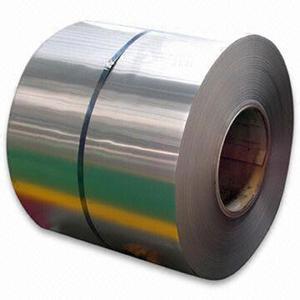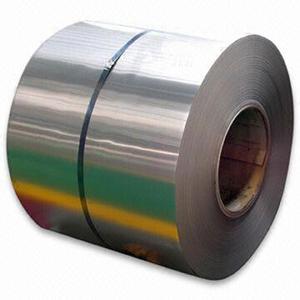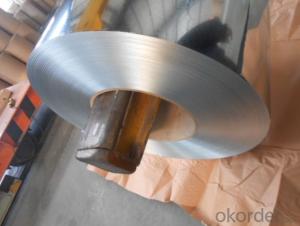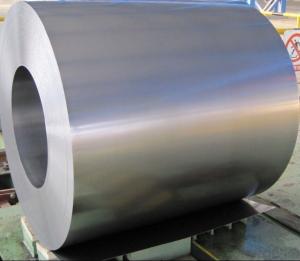Hot dipped Galvanized Steel Coil Zero Spangle
- Loading Port:
- China Main Port
- Payment Terms:
- TT or LC
- Min Order Qty:
- -
- Supply Capability:
- -
OKorder Service Pledge
Quality Product, Order Online Tracking, Timely Delivery
OKorder Financial Service
Credit Rating, Credit Services, Credit Purchasing
You Might Also Like
HOT DIP GALVANIZED STEEL COIL
Specification:0.4mm*1000mm*c
Steel Grade & Standard: ASTM A653
Zinc Coating Mass:Z180 Spangle:Zero Spangle
Surface Treatment: non-chromate, oiled
Coil ID:508mm Coil Weight:6-10MT
Package Type:EYE TO SIDE
Thickness Tolerance:+/-0.02mm Width Tolerance:+/-5mm
Zinc Coating Tolerance:-/+10g/m2
- Q: How do steel coils contribute to sustainability efforts?
- Steel coils contribute to sustainability efforts in several ways. Firstly, steel coils are made from recycled steel, reducing the need for virgin raw materials and minimizing the environmental impact of mining and processing. Additionally, steel coils are highly durable and long-lasting, meaning that products made using steel coils have a longer lifespan, reducing the frequency of replacements and waste generation. Furthermore, steel is a highly recyclable material, and steel coils can be easily recycled at the end of their life, making them a sustainable choice.
- Q: What are the common methods of cutting-to-length steel coils?
- The common methods of cutting-to-length steel coils include shearing, slitting, and sawing.
- Q: and which one is better?i'm looking into buying some aftermarket headers, but companies make them in both chrome and stainless steel
- Chrome looks better, but it will eventually rust if it's exposed to enough moisture. Stainless steel will not rust. I would spend the extra money and get the stainless headers.
- Q: What are the properties of high-strength steel coils?
- High-strength steel coils possess several distinct properties that make them highly desirable in various industrial applications. Firstly, these coils exhibit exceptional strength, meaning they have a high tensile strength and can withstand significant amounts of force or weight without deformation or breakage. This property allows them to be used in demanding environments or for heavy-duty purposes. Another key property of high-strength steel coils is their excellent resistance to wear and tear. They have a high level of hardness, which enables them to resist abrasion, impact, and other forms of mechanical stress. This makes them ideal for applications where durability and longevity are crucial, such as in construction, automotive manufacturing, and machinery production. Additionally, high-strength steel coils often possess excellent corrosion resistance. They are typically coated or treated with protective materials to prevent rust or other forms of deterioration caused by exposure to moisture, chemicals, or harsh environmental conditions. This corrosion resistance property ensures the longevity and reliability of the coils, making them suitable for applications in marine environments or outdoor structures. High-strength steel coils also offer good formability, meaning they can be easily shaped or bent without losing their strength or integrity. This property allows manufacturers to create complex or custom shapes for specific applications, enhancing their versatility and adaptability. Lastly, high-strength steel coils are known for their light weight compared to other materials with similar strength properties. This low weight-to-strength ratio makes them a preferred choice in industries where weight reduction is crucial, such as aerospace or automotive manufacturing. It allows for improved fuel efficiency, increased payload capacity, and overall cost savings. In summary, high-strength steel coils exhibit properties such as exceptional strength, resistance to wear and tear, corrosion resistance, formability, and light weight, which make them valuable and versatile materials in various industries.
- Q: How are steel coils processed before they are used in manufacturing?
- Before being used in manufacturing, steel coils undergo several processing steps. The initial step, known as pickling, entails immersing the coils in an acid bath to eliminate any surface impurities such as rust or scale. This step serves to enhance the surface quality of the steel. After pickling, the coils are subjected to a process called cold rolling. This involves passing the coils through a set of rollers to decrease their thickness and enhance their dimensional accuracy. Additionally, cold rolling enhances the mechanical properties of the steel, rendering it stronger and more durable. Following cold rolling, the coils are annealed. This process involves heating the coils to a specific temperature and gradually cooling them. Annealing helps to alleviate internal stresses within the steel and improve its formability and ductility. Subsequently, the coils may undergo further surface treatments, such as galvanizing or coating. Galvanizing involves applying a layer of zinc to protect the steel from corrosion, while coating may involve applying various types of paint or polymer to enhance the steel's appearance or provide specific functionalities. Once the coils have undergone the necessary processing and treatments, they are typically cut into smaller sheets or strips according to the manufacturing requirements. These sheets or strips can then be utilized in various manufacturing processes, including stamping, forming, welding, or fabrication, to create a diverse array of products, ranging from automotive components to appliances, construction materials, and more. In summary, steel coils go through a series of processing steps, including pickling, cold rolling, annealing, and surface treatments, before they are prepared for use in manufacturing. These processes result in improved quality, strength, and formability of the steel, enabling it to be transformed into a wide range of products.
- Q: Can steel coils be used in the production of consumer goods?
- Yes, steel coils can be used in the production of consumer goods. Steel coils are typically used as raw material in various industries, including automotive, construction, and manufacturing. In the consumer goods industry, steel coils can be used to produce a wide range of products such as appliances, furniture, tools, packaging materials, and even consumer electronics. The inherent strength, durability, and versatility of steel make it an ideal choice for manufacturing consumer goods that require stability, safety, and longevity. Additionally, steel coils can be easily shaped, molded, and formed into different components or parts, allowing for customization and design flexibility in the production process. Therefore, steel coils play a crucial role in the production of consumer goods and are widely used across various sectors.
- Q: How are steel coils used in the production of metal signs?
- Steel coils are used in the production of metal signs by being processed through a series of steps such as cutting, shaping, and welding. The coils are uncoiled and cut into the desired size and shape for the sign. Then, they are shaped using various methods like bending or rolling to achieve the desired design. The coils may also undergo welding to join different sections or add additional components to the sign. Overall, steel coils provide the raw material necessary for creating durable and sturdy metal signs.
- Q: What are the common coil packaging materials?
- The common coil packaging materials include stretch film, shrink wrap, steel strapping, and wooden or cardboard cradles.
- Q: I need steel toe shoes for a workplace, where can I get them?I live in Surrey,UK.
- by on the internet or ppe clothing shops
- Q: What are the different types of steel coil edges?
- Various steel coil edges exist, each possessing unique characteristics and applications. 1. Mill Edge: The most prevalent type, it is obtained by cutting the coil at the mill without undergoing any further processing or treatment. Mill edge coils have a natural, slightly rounded edge, making them suitable for a wide array of applications. 2. Slit Edge: Slit edge coils are created by cutting the coil across its width using a slitting machine. This results in a straight and smooth edge, making them ideal for precise measurements needed in automotive parts or electrical components. 3. Deburred Edge: Deburred edge coils have undergone an additional process to eliminate any burrs or sharp edges that may exist after slitting. This ensures safer handling and reduces the risk of damage during fabrication or installation. Deburred edge coils are commonly used in the construction industry, particularly for structural steel components. 4. Rounded Edge: As the name implies, rounded edge coils possess a curved edge profile achieved through a specific rolling process. This creates a smooth and curved edge, making them often utilized in applications prioritizing safety, such as the manufacturing of household appliances or kitchen equipment. 5. Sheared Edge: Sheared edge coils are produced by cutting the coil using shearing blades, resulting in a straight edge with a slight burr. While sheared edge coils may have a rougher finish compared to other edge types, they are still frequently used in applications that do not require a high level of precision, like general fabrication or shelving. In summary, the choice of steel coil edge depends on specific application requirements, including factors such as measurement precision, safety considerations, and aesthetic preferences.
Send your message to us
Hot dipped Galvanized Steel Coil Zero Spangle
- Loading Port:
- China Main Port
- Payment Terms:
- TT or LC
- Min Order Qty:
- -
- Supply Capability:
- -
OKorder Service Pledge
Quality Product, Order Online Tracking, Timely Delivery
OKorder Financial Service
Credit Rating, Credit Services, Credit Purchasing
Similar products
Hot products
Hot Searches
Related keywords























